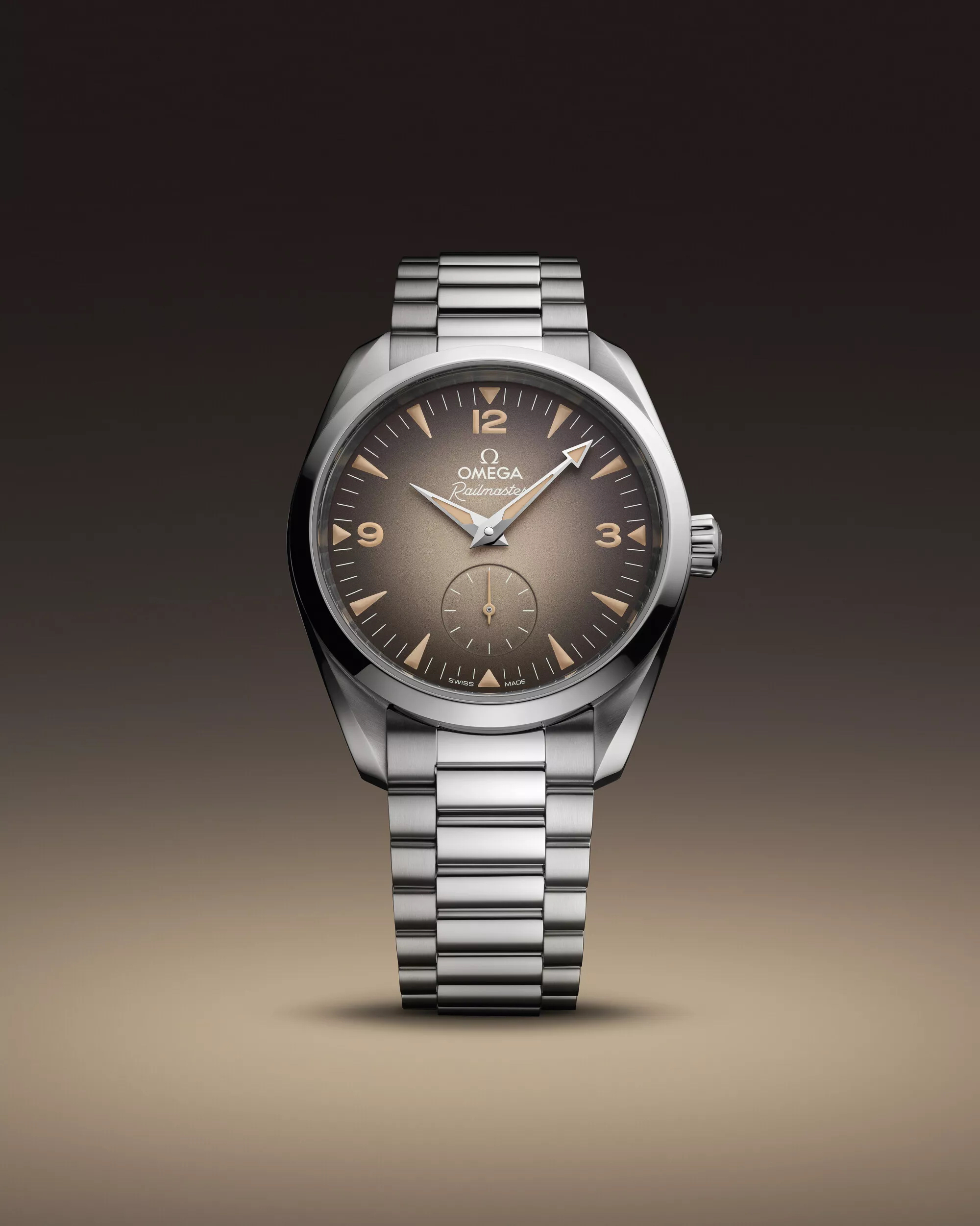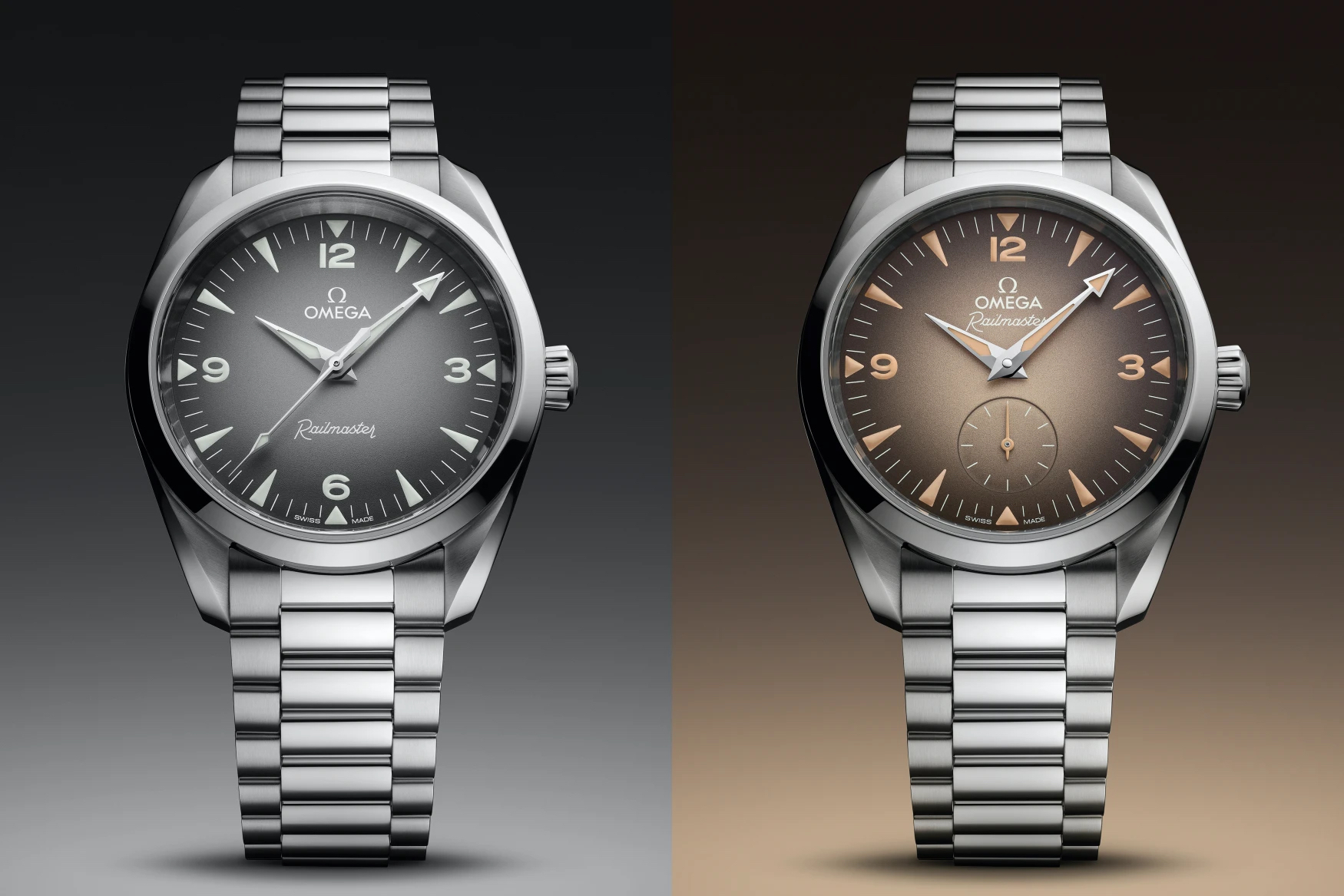Originally made for Railway professionals in 1957, Omega has updated the Railmaster for 2025.
Omega produced two dial variants for the new Seamaster Railmaster, one with a matte gray gradient that has a lighter shade of gray in the center and becomes almost black at the periphery. The other dial is rendered in a matte light brown hue in the center and becomes dark brown at the edges. Each variant comes with either a stainless steel bracelet or a two-stitch leather strap, for a total of four references.
Offered in a 316L stainless steel, symmetrical, twisted-lug case measuring 38 mm x 12.4 mm and 44.9 mm lug-to-lug, the 2025 Seamaster Railmaster weighs 79 grams on a leather strap or 136 grams on the integrated stainless steel bracelet.
Oddly, the lug width is 19 mm, which would have been more compatible with third-party strap options at 20 mm, but it’s not that big of a deal, especially if you plan to stay with the factory options. The bracelet features a hidden deployant clasp and tapers from 19 mm to 17 mm, and the strap tapers from 19 mm to 16 mm with a folding stainless steel clasp.
All models are powered by an 3.5Hz automatic bi-driectional winding Co-Axial Master Chronometer with a free sprung balance, silicon balance spring, traversing balance bridge, black screws, and are resistant to resistant to magnetic fields up to 15,000 gauss. The 35-jewel movement is decorated with a rhodium-plated rotor and bridges with Geneva waves in arabesque, and leaves the factory adjusted to an impressive +0/-5 seconds per day. Holistically, Omega movements are a high point when considering competitors such as Tudor and Cartier, and even to some extent, Rolex. Although if you want to nitpick, a lower oscillation frequency of 3.5Hz versus 4Hz is something that might deter ultra detail-oriented consumers in this price point.
Interestingly, the gray dial versions have a center seconds display, powered by caliber 8806, that offers a 55-hour maximum power reserve. Whereas, the brown dial versions have a small seconds display at 6 o’clock and offer a slightly longer maximum power reserve of 60 hours.
The hour and minute hands are stainless steel and have a Dauphine shape for hours and a large arrow-tipped hand for minutes. Rather than applied indices, all the markings on the dial have been printed, which looks right for a watch that has a retro aesthetic.
The gray dial version features a white luminous paint that emits in both blue and green, whereas orange-hued vintage-type lume, with blue emission, punctuates the dial on the brown version. Notably, on the gray dial, the Railmaster text is stamped at 6 o’clock, and it’s stamped at 12 o’clock on the brown dial.
All four 2025 Seamaster Railmaster models come with a sapphire crystal, a conical-shaped screw-down crown, a transparent screw-in caseback, and a water-resistant rating of 150 meters.
It’s unclear why there’s any price difference between the dials, but the gray versions with center seconds hands are $5,400 on the strap and $5,800 on the bracelet, and the brown variants are $6,000 on a strap and $6,400 on a bracelet. Omega is charging a whopping $600 premium for the small seconds model, which, other than the vintage-esque dial, single instead of dual emission lume, and a 5-hour longer power reserve and slightly different movement mechanics required for the small seconds function, is the same.
Whether this refresh will boost sales or come off as iterative remains to be seen; however, knowing how finicky watch collectors tend to be, especially about price (as they should be), the $600 price difference between similar models will surely be a point of contention, at a time when Omega reportedly continues to lose market share to Rolex and Cartier (according to Morgan Stanley’s latest estimated Swiss brand rankings), and thus cannot risk being tone deaf.
Approximately speaking, Omega is positioned just above Tudor, just below Rolex, and inline with Cartier. Their price points can intersect, and some buyers certainly have the means to consider a more expensive alternative for the other. Moreover, some consumers might also opt for less expensive yet formidable options from Tudor. My point is that Omega has long been known as a less pretentious upscale value-priced Swiss brand, and they still offer that; however, as their price points continue to creep upwards, this could be costing them market share despite the trend mentioned by virtually every Swiss watch executive about selling at higher price points to fight against an ongoing trend of lower unit volume. Perhaps the executives in Biel-Bienne should be more proactive and lead the market instead of just settling for the status quo.
Learn more at Omega.
Photo by Omega.





